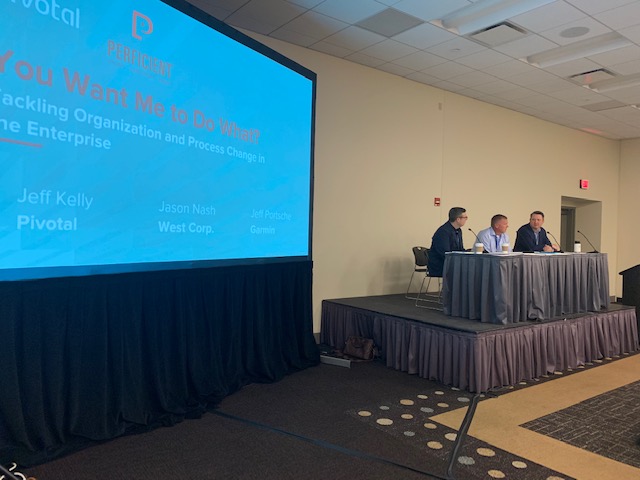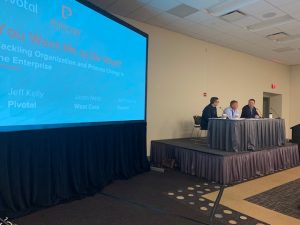Yesterday, experts from Pivotal, Garmin, and West Corporation gathered during St. Louis’ annual Gateway to Innovation conference to discuss organizational and process change, and how their enterprises have tackled those challenges.
During the session, the panelists shared solutions they used to address obstacles they faced when adopting a team approach, adapting people and processes stubborn to change, and aligning different groups with competing priorities. Curious to see what some of these solutions looked like? Here are four key takeaways from the panel:
- Create Buy-In
With change, comes adversity. Not every individual in your organization will be lining up at your door to volunteer. However, as Jason Nash noted during the session, if you have influential members in your organization backing your new approach, others will soon follow. Spend some time with these leaders in your organization and show them how this transformation will positively affect business – and then let them spread the word.
- Change Your Mindset
One thing that both Nash and Portsche highlighted was changing your mindset BEFORE you begin implementing process change was important. Many organization begin with a project mindset. For example, “I have Project A, and that is going to produce X by this date”. Switching your enterprise from this mindset to a more “product based” mindset is tough, but one that is necessary. With process change management, you are moving to the notion that you have a product you are investing in to produce revenue – and produce it faster than your competitors. This is something both developers, and your finance teams will need to implement. Once your product owners (and other teams) can move their mindset to this, you’ll see change happening much faster.
- Speak Their Language
Another common challenge organizations face with change management, is the ability to align the enterprises different constituencies that have competing priorities. For example, balanced teams want to go fast and release frequently, but security and compliance want to slow things down in the belief that going slow is safer. For Jeff Portsche, overcoming this challenge is all about articulating the priorities to other groups, and setting goals for aligning your teams. “Speak in a language they understand, and give them metrics that they are familiar with. This will help them trust your decision making and ultimately help to earn their buy in,” said Portsche. By showing them statistics and proof that the new process is beneficial (proof is in the pudding!), groups will soon be interested and excited, and take this positive attitude to other groups to continue aligning.
- Have a Trusted Partner
Why should you have to approach organization and process change alone? Having partners who understand the process not only ensures you are taking the most beneficial route to change, but also with aligning your organization. For Nash and Portsche, having both Pivotal and Perficient was a game changer. With Pivotal’s expertise on their multi-cloud platform, Pivotal Cloud Foundry, Portsche didn’t have to worry about knowing the answer to every single question his Garmin teams had about the transformation. Pivotal was there to back him up, and show his team the benefits to their product. It helped to show people where the product comes from, and to understand the concepts. For Nash, Perficient was able to streamline the process of staffing West Corporation’s application transformation. Instead of spending months interviewing and hiring for their new product, Perficient was able to provide a team of experts to get the concept moving and off the ground.
And finally, their advice to you – believe in the process. Transformation and change is difficult, but there is a reason why you are doing it.




